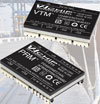

A company called Scientific Solutions recently employed V·I chips from Vicor in the development of a novel technology based on sonar.
Scientific Solutions is a small company of 23 employees that characterises itself as specialising in rapid prototyping of harsh environment instrumentation and ocean-acoustic research. The company’s experience making difficult noise and vibration measurements has been applied to diverse uses. One application, for example, is an active sonar that can detect submarines too quiet to be found with passive sonar. Another system detects large marine mammals to prevent their harm in shipping lanes or in high sound pressure zones such as during military exercises.
One particular new product for which a power solution was sought was a sonar system that can detect intruders in a particular area – such as for harbour defence. The system transmits and receives signals that can then be interpreted to identify what has been detected, such as a swimmer or a small underwater vehicle.
The prototype system used an older power supply that presented a problem. The sonar system transmits a signal and waits to receive a reflected signal in response. During that portion of transmit and receive, the power supplies are at no load and switching in the same frequency band that the system is looking at, making noise an issue. One of the benefits of Vicor’s V·I chips is that they operate on a fixed higher frequency, which switches above the band that the sonar system uses. This made them an ideal solution for Scientific Solutions as they created no interfering noise.
It is desirable to ensure that such a defensive system is as unobtrusive and unnoticeable as possible. In this application the complete sonar system was built into a cylindrical can that is placed in the water and attached to hydrophone transducers. Vicor’s PRM and VTM power modules are connected in a high-power parallel array. The 48 V PRM and VTM array provides control of isolated point-of-load (POL) voltages of 48, ±15, ±12 and 5 V. As the overall power requirements for the transmit system were high (about 1 kW), and because the underwater system needed to be as small as possible, the high power density and small size of the V·I chips were critical.
The high efficiency of V·I chips was a particularly valuable attribute for this program because in a can under water there is no air circulation; yet heat had to be kept to a minimum to ensure the required high reliability levels. Taking the heat out of the can and into the water was, therefore, a big priority. Indeed, Scientific Solutions had a requirement to keep the internal temperature in the can at a specific temperature. As the chips do not dissipate much power when they are loaded, they were ideal for this application.
“The inherent low noise of the V·I chips is important because we are working with signal power levels that are very low. The received signals are amplified, so any noise present will be amplified as well. Being inherently low noise has helped a lot,” Sung Vivathana, an electrical engineer at the company said. “Size was definitely important as well because, in addition to the need to be unnoticed, the material used to house all of the electronics is fairly expensive per square foot, so the smaller the better.”
The speed and level of Vicor’s support was an important element in the design’s success, from the initial enquiry to production. In particular, Vicor’s applications engineers worked with the designers at Scientific Solutions from the initial stages of developing the complicated PRM/VTM parallel array through to assisting with PCB layout.
Vivathana added, “Scientific Solutions has always used Vicor products in the past for their reliability. With this new design, we are using the V•I chips because they alone offered the density, noise and size attributes that are critical to this specific application.”

© Technews Publishing (Pty) Ltd | All Rights Reserved